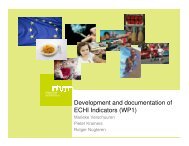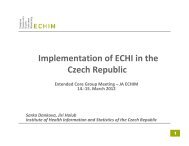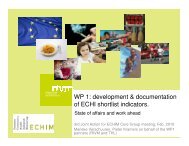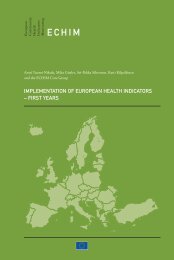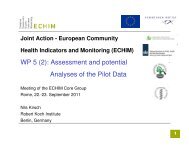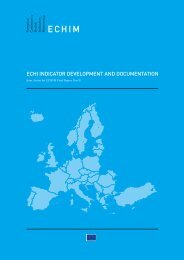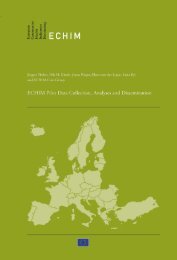INDICATORS
ECHIM Final Report
ECHIM Final Report
Create successful ePaper yourself
Turn your PDF publications into a flip-book with our unique Google optimized e-Paper software.
56. VACCINATION COVERAGE IN CHILDREN<br />
Definition: Percentage of infants reaching their a) first and b) second birthday in the given<br />
calendar year who have been fully vaccinated (according to national immunisation schemes)<br />
against selected important diseases such as: diphtheria, tetanus (DPT), pertussis (whooping<br />
cough), measles (2 nd birthday), poliomyelitis, invasive disease due to Haemophilius<br />
influenzae type b, hepatitis B, mumps (2 nd birthday) and rubella (2 nd birthday).<br />
Calculation:<br />
1) The EU Social Protection Committee indicator (HC-P6): a) Percent of infants reaching<br />
their 1st birthday in the given calendar year who have been fully vaccinated against pertussis<br />
(whooping cough), diphtheria, tetanus (DPT) and poliomyelitis; and b) Percent of infants<br />
reaching their 2nd birthday in the given calendar year who have been fully vaccinated against<br />
measles, mumps and rubella (MMR)<br />
2) OECD: Percentage of children reaching their first birthday who have been fully<br />
immunised against a) Diphtheria, Tetanus and Pertussis (DTP) taken together; and b)<br />
seperately for measles, Hepatitis B and influenza; out of all children in the respective age<br />
group.<br />
3) Child Health Indicators of Life and Development (CHILD) project: Immunisation rates<br />
for childhood immunisation, expressed as children aged 24–35 months inclusive having<br />
completed primary courses of immunisation as a percentage of all children in that agegroup,<br />
separately for the following antigens: diphtheria, pertussis, tetanus, poliomyelitis,<br />
haemophilus influenza type b, measles, mumps, rubella, hepatitis B, meningococcus C.<br />
Notes: Immunisation schemes are not harmonised in the EU. The age of complete<br />
immunisation differs across countries due to different immunisation schedules. The<br />
vaccination coverage in children has to be calculated according to the national schemes.<br />
The vaccination coverage is calculated as the percentage of children that have been fully<br />
vaccinated against a specific disease out of all children in the respective age group.<br />
57. INFLUENZA VACCINATION RATE IN ELDERLY<br />
Definition: Influenza vaccination is defined here as individuals who have received one shot<br />
of Influenza Vaccine (brand name to be verified in each country) during the 12 months<br />
preceding the interview.<br />
Calculation: Percentage of persons aged 65 and older reporting to have been vaccinated<br />
against influenza during the last 12 months, derived from EHIS questions PA.1, PA.2 and<br />
PA.3. PA.1: Have you ever been vaccinated against flu? 1. Yes / 2. No; PA.2: When were you<br />
last time vaccinated against flu? 1. Since the beginning of this year / 2. Last year / 3. Before<br />
last year<br />
PA.3: Can I just check, what month was that? Month (01–12).<br />
Notes: Recall period of 12 months to count only one influenza season. The above definition<br />
excludes those who were offered a vaccination, but were in fact not vaccinated.<br />
117



